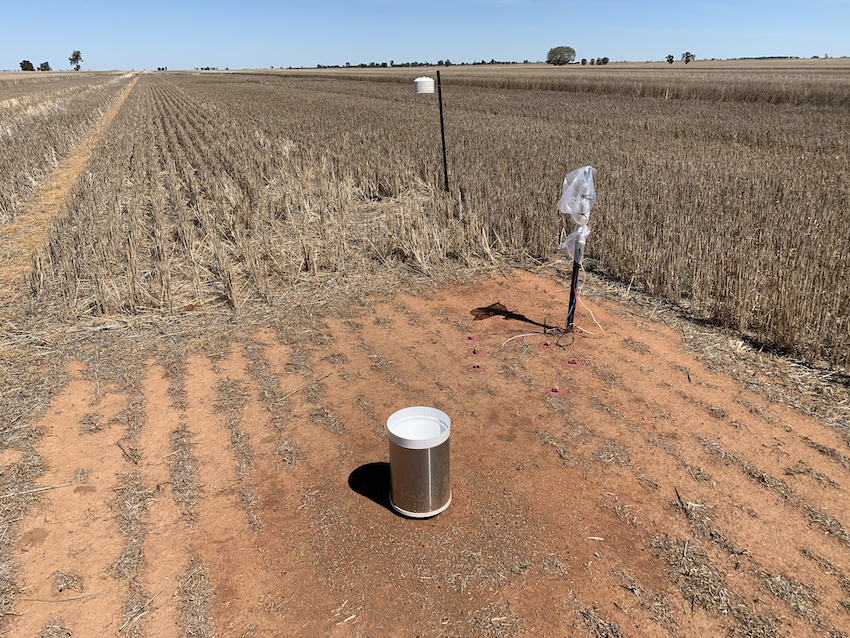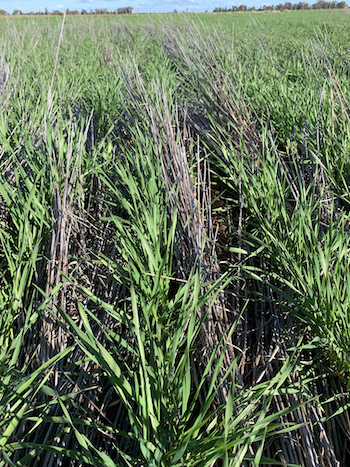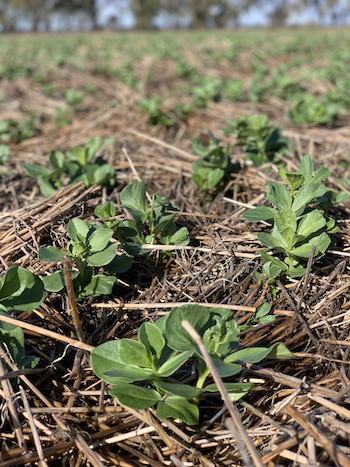The adoption of stripper fronts for harvesting cereal crops has increased over the past decade. The practice leaves tall standing stubbles that growers in high residue farming systems prefer. Perceived benefits include increased groundcover over the summer fallow, improved harvest capacity and reduced hairpinning in disc seeding systems.
The differences in stubble architecture created by stripper versus draper header fronts is being investigated to better understand impacts on the capture, maintenance and storage of soil moisture – in other words, on fallow efficiency dynamics. This project focused on the cereal component of the farming system in southern NSW. The aim was to address key crop establishment, development and yield metrics, thereby facilitating decisions about the use of stripper fronts.

Trial set-up for measuring soil moisture including Chameleon sensors, soil temperature loggers and rain gauge. Photo: Grassroots Agronomy
Trial design
 Barley emerging through stripper stubble. Photo: Grassroots Agronomy
Barley emerging through stripper stubble. Photo: Grassroots Agronomy
The work was undertaken as a collaborative venture between CSIRO, FarmLink, Charles Sturt University (CSU) and Grassroots Agronomy. The study was initially designed around four paddock-scale replicated trials located at Junee Reefs, Matong, Quandialla and Urana. The project measured and analysed the effects of stubble length and architecture on:
- water capture, storage and conversion to grain yield;
- stubble breakdown rates;
- impacts on soil surface conditions, notably wind speed;
- canopy temperature; and
- weed emergence, pest incursions and impacts of control measures.
Grower-collaborators were engaged to conduct the paddock-scale trials with their own farm machinery, with crops sown with a disc seeder. This reduced any establishment risk around stubble handling across a range of treatments.
Measurements commenced in 2021 and continued until harvest 2022. Additionally, CSU had ongoing trial sites from the previous three years that were continued in 2021 and 2022 at Collingullie and Lockhart.
Trial outcomes
 Pulses emerging through stripper stubble. Photo: Grassroots Agronomy
Pulses emerging through stripper stubble. Photo: Grassroots Agronomy
The project was fortunate to have some great collaborating growers who were able to establish seven large-scale experiments when the project commenced in December 2020.
In the first year (2020-21), favourable summer rains in February and March were followed by a dry period prior to sowing in April. This provided an excellent scenario to examine differences in surface and stored soil moisture pre-sowing in 2021.
Two very wet years then followed, which caused issues with paddock operations and data collection. By the autumn–winter of 2022, all sites were left unsown by the growers, with trafficability a major issue. CSU was able to maintain a site at Lockhart in 2022.
Overall, data was collected across the different sites in the fallow period of 2020-21 and 2021-22. CSIRO and FarmLink now have results from:
- Chameleon sensors on the shallow soil water potential;
- soil temperature;
- the start and finish stubble weights (standing and flat totals) at mid-fallow and pre-sowing; and
- gravimetric soil water at harvest and pre-sowing.
At CSU, the focus was on windspeed and temperature data at different heights within the stubble. This data is expanding our understanding of stubble microclimates. This team also took shallow TDR (Time Domain Reflectometry) soil water and temperature recordings and stubble weights mid-fallow and pre-sowing.
An important use for the field data is to help develop computer models that can extrapolate stubble architecture impacts on soil moisture to other sites across Australia and across different seasonal conditions. Such a model has been developed by CSIRO in a project headed by Dr Kirsten Verburg using the field trial data. The model is currently undergoing verification to ensure it can dig down all the way to impacts at the level of the stubble's microclimate.
The project owes a special thanks to the growers for their time and patience plus the research teams that conducted this work, including Tony Swan and Kirsten Verburg at CSIRO, James Holding and Hayden Thompson at FarmLink and John Broster and Phillip Eberbach at CSU.
More information: Greg Condon, greg@grassrootsag.com.au

























































